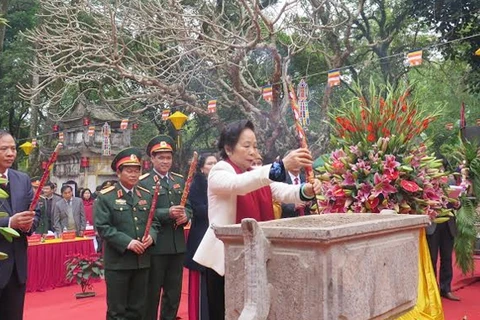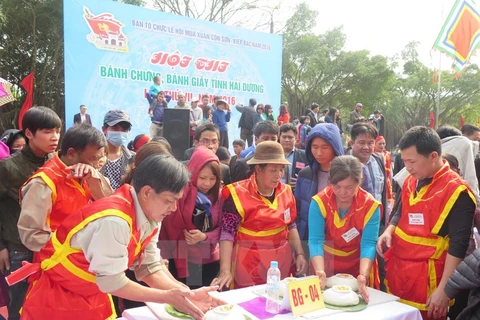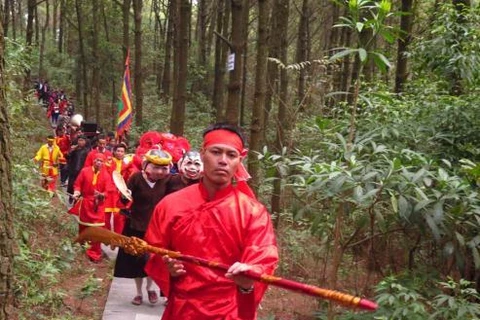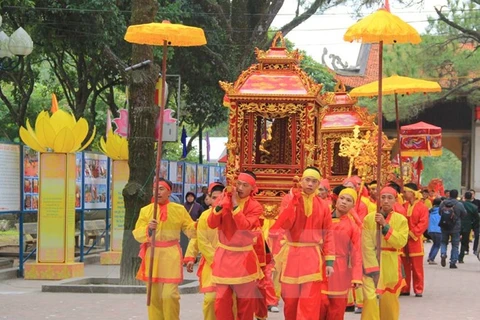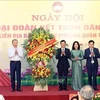 Con Son-Kiep Bac Complex exudes serenity. It was recognised as a special national relic in 2012 (Photo: thegioidisan.vn)
Con Son-Kiep Bac Complex exudes serenity. It was recognised as a special national relic in 2012 (Photo: thegioidisan.vn) Hanoi (VNA) - “Con Son suoi chay ri ram/ Ta nghe nhu tieng dan cam ben tai” (Con Son’s streams are babbling/ As music from a stringed instrument)
The beauty and serenity evoked in this line from 15th-century poet Nguyen Trai’s Con Son Ca (Con Son Ballad) still come to mind when visiting the Con Son-Kiep Bac Complex today.
The complex of pagodas and temples nestles amidst forested mountains in the Con Son area’s Chi Linh district, Hai Duong province.
The most prominent structures in the complex are the Con Son Pagoda and the Kiep Bac Temple, havens of peace and quiet, some 80 kilometres from central Hanoi.
The sacredness of the pagoda, believed to have been built in the 13th century, is encapsulated in the famous saying: “Con Son, Yen Tu, Quynh Lam/ Neu ai chua den thien tam chua danh” (Those who haven’t been to Con Son, Yen Tu and Quynh Lam haven’t completed their pilgrimage).
Con Son together with Yen Tu and Quynh Lam pagodas, in Quang Ninh province, are three major centres of Trac Lam Zen Buddhism in Vietnam.
All three founders of Truc Lam Zen – King Tran Nhan Tong, Venerable Phap Loa and Venerable Huyen Quang – have been to the Con Son Pagoda to offer teachings on Buddhism, making it a major institution of learning under the Tran Dynasty (1225-1400).
About five kilometres from the Con Son Pagoda stands the Kiep Bac Temple, dedicated to one of the most accomplished commanders in the nation’s history, Tran Hung Dao, who commanded the country’s armies to repel three Yuan-Mongol invasions in the 13th century. He is honoured as a saint in Vietnam.
After the first victory over the invaders, Tran Hung Dao chose the Kiep Bac area as a military base. In 1285, he gathered more than 20,000 soldiers, more than 1,000 fighting ships and achieved the second victory here.
The temple was to honour the commander’s valour dedication in 1300. The structure was damaged during subsequent wars and the wear and tear of time. It was reconstructed in the late 19th century.
Archaeological excavations have affirmed that Kiep Bac used to be a military base in the 13th century that included temple dedicated to a living person, a sail workshop, rice barns, caves and ponds.
In a 2013 archaeological excavation at the Con Son Pagoda, a diverse range of artefacts were found, including building materials (bricks, tiles, terracotta decorative items with different motifs); and porcelain (bowls, plates, vases) made in Vietnam and China. Most of the artefacts belonged to the Tran Dynasty in the 14th century and the Le Dynasty in the 17th century, confirming the pagoda’s importance as a Buddhist relic in Vietnam under the two dynasties, according to the management board of the Con Son-Kiep Bac relic.
The excavation also unearthed vestiges of a nine-storey lotus tower for the first time, providing a reliable foundation for reconstructing the tower in 2014.
Century old festivals
 Every year, Con Son-Kiep Bac complex hosts the Spring and Autumn Festival. One commemorates the death anniversary of Venerable Huyen Quang and the other pays tribute to Tran Hung Dao (Photo: VNA)
Every year, Con Son-Kiep Bac complex hosts the Spring and Autumn Festival. One commemorates the death anniversary of Venerable Huyen Quang and the other pays tribute to Tran Hung Dao (Photo: VNA) Every year, the complex hosts two major events – the Spring and Autumn festivals. The spring festival is held on the first lunar month, commemorating the death anniversary of Venerable Huyen Quang, one of the first three patriarchs of Truc Lam Zen Buddhism.
The autumn festival, which pays tribute to Tran Hung Dao, is held in the eighth lunar month. The festivals feature a range of rituals including the floating of colourful lanterns, a water procession, a Buddhist ritual that prays for the nation’s peace and security. Thousands of Buddhists and other people participate in them.
Wrestling contests and banh chung (square sticky rice cake) making competitions, boat races, water puppetry performances and folk games are also organised.
The Con Son-Kiep Bac complex was listed as a national relic in 1962 and as special national relic in 2012. The festival was recognised as a national intangible heritage in 2013.
The complex is among more than 3,400 national relics. Of these more than 1,000 are communal houses, nearly 800 pagodas and around 600 temples, according to the Institute for Conservation of Relics.
“There is hardly any religious relic where all the original elements are preserved till today. Meanwhile, to ensure conservation and continuation of its initial function (a place for religious practice), a relic must be in full and intact state. Thus, restoring the lost items of relics is an imperative, urgent task,” said Dr Hoang Dao Kinh, an architect from Hanoi who specialises in the restoration of heritage structures.
He said: “The increasing demand for relic restoration poses a big question – what are the factors and sources should we rely on to carry out conservation work?”
Science and tradition
The Cultural Heritage Law of Vietnam regulates that "conservation of a relic must preserve the original elements of a structure as much as possible".
Researchers agreed that a scientific approach was needed to ensure the authenticity and integrity of a relic when attempts are made to conserve or reconstruct it.
 A 14th century stele in the Con Son pagoda was listed as national treasure in 2015. It is among very few Tran Dynasty artefacts that exist today (Photo: VNA)
A 14th century stele in the Con Son pagoda was listed as national treasure in 2015. It is among very few Tran Dynasty artefacts that exist today (Photo: VNA)“We need to preserve the value of the relic as well as the cultural message that our ancestors wanted to pass down to us. The pagodas and temples serve as vehicles transporting the historical memory and cultural message to the present,” said Dang Van Bai, vice chairman of the National Heritage Council.
Backing him, history professor Tran Lam Bien, who has 60 years of experience in conservation, added: “Every element in a Buddhist structure has its own meaning. Therefore, conservation of relics must be done in consultation with scientists and researchers. We can do good conservation work only with profound understanding of the relic.”
Elaborating on this, Luu Tran Tieu, chairman of the National Cultural Heritage Council, said: “Each historical and cultural relic is a witness to development stages in the nation’s history, on which historical, cultural and aesthetic values are imprinted. Therefore, the most significant requirement of conservation work is to preserve the relic’s historical and cultural authenticity.
“Original elements can be preserved for a long term by various techniques including preventing termite damage, periodic maintenance, upgrading (reinforcing, mending, adjacenting); repairing damaged elements or replacing them with new ones based on research and comparison with existing features of the relic or comparison with other architectural relics of the same age in the neighbourhood.
“In case the relic has deteriorated seriously, a dismantlement plan (recording, numbering, drawing, photographing the elements) is necessary. After maintenance work is conducted, the structure must be reassembled in a precise manner.
“Reconstruction is justified only in exceptional circumstances and then it must be done based on scientific documents,” said Tieu.
Scientific documentation includes writings about the relic, its foundation; the decorative architectural artifacts found during excavation; and photographs of the relic before it was damaged.
Model work
Since 2010, Hai Duong has carried out several conservation projects, including that of the Kiep Bac Temple, reconstructing the nine-storey lotus tower and maintaining some compartments as well as the bell tower of the Con Son Pagoda.
 The nine-storey lotus tower symbolising nirvana, the state of enlightenment that Amitabha inhabits was reconstructed in 2014 and inaugurated last year (Photo courtesy of Con Son-Kiep Bac relic management board)
The nine-storey lotus tower symbolising nirvana, the state of enlightenment that Amitabha inhabits was reconstructed in 2014 and inaugurated last year (Photo courtesy of Con Son-Kiep Bac relic management board)The restoration of the tower and conservation of other elements in the Con Son Pagoda were done after intensive and extensive study of historical documents and existing architectural peers in the region, said Nguyen Khac Minh, head of the Con Son-Kiep Bac Relic Management Board.
Last year, the nine-storey tower was inaugurated during the Con Son-Kiep Bac festival. The original tower was built by Venerable Huyen Quang during the reign of the Tran dynasty and lost after the Le dynasty took power.
The tower, which symbolises nirvana, the state of enlightenment that Amitabha inhabits, has a statue of Amitabha on the top floor and more than 200 other Buddha statues.
“The Con Son-Kiep Bac Complex can be considered as a model for how we should treat our relics,” Bai said.
It’s only two months till the 2018 spring festival opens (the 16th day of the first lunar month), and the complex will welcome thousands of visitors and Buddhists from all over the country.
Locals are the most excited, of course.
Hoang Thi Mai, a native of Chi Linh district, said: “The festival season is always an important and fun time of the year for us. I am proud that I will play a role in the water procession.”-VNA
VNA


